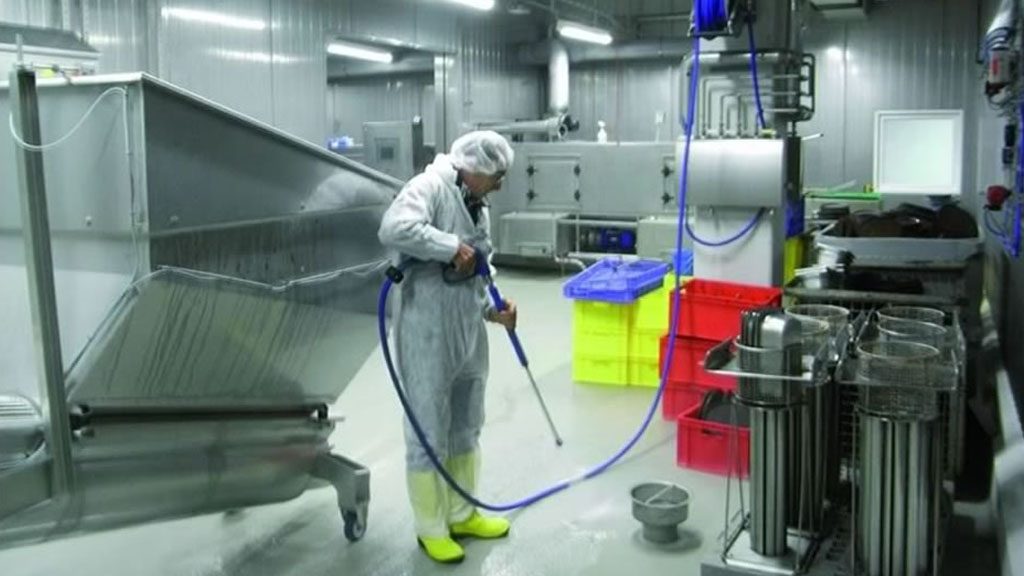
Cleaning and sanitizing is probably in one of most important aspects in food and beverage processing plants, an effective sanitation program is the key factor to guarantee product quality. In addition, cleaning and sanitation has an important impact in Public Health, according to recent data from the Centers for Disease Control and Prevention, about 48 million people in the U.S. (1 in 6) get sick, 128,000 are hospitalized, and 3,000 die each year from foodborne diseases.
The FDA Food Safety Modernization Act (FSMA), focus on preventing foodborne illness, sanitation has a dramatic role in global food system and in our understanding it consequences, which may include public health issues and a threat to the economic well-being of the food system.
‘‘(3) PREVENTIVE CONTROLS.—The term ‘preventive controls’ means those risk-based, reasonably appropriate procedures, practices, and processes that a person knowledgeable about the safe manufacturing, processing, packing, or holding of food would employ to significantly minimize or prevent the hazards identified under the hazard analysis conducted under subsection (b) and that are consistent with the current scientific understanding of safe food manufacturing, processing, packing, or holding at the time of the analysis. Those procedures, practices, and processes may include the following:
‘‘(A) Sanitation procedures for food contact surfaces and utensils and food-contact surfaces of equipment.”
Before discussing the chemicals, we need to understand differences between cleaners and sanitizers:
Cleaning is the complete removal of food soil using appropriate detergent chemicals under recommended conditions. It is important that personnel involved have a working understanding of the nature of the different types of food soil and the chemistry of its removal.
Treatment of a cleaned surface with a chemical or physical agent to destroy disease/spoilage causing organisms.
What are the Basic Chemistries of Sanitizers used in the Food and Beverage Industry:
Types of Sanitizers:
Advantages: Not Affected by Hardness, Oxidizer, Low Cost
Disadvantages: pH range 5-7 most effective, Affected by organic loading, Temperature Instability, Corrosion
Chemicals Global Chlorine Sanitizer: SHS-900
Advantages: Effective in Acid or alkaline environment
Disadvantages: Hard water interference
Chemicals Global Quat Based Sanitizer: Neuquat
Advantages: Less reactive with organics than Chlorine
Disadvantages: Staining, More concentrated / Less Active
Chemicals Global Iodophor Sanitizers: Dicasan IO
Advantages: Oxidizer, Function at low temperature, More active than Chlorine, Iodine; Not affected by organic loading
Disadvantages: Corrosion, Safety in Handling, Odor
Chemicals Global Peracetic Acid Sanitizers: Dicasan PAA
Advantages: Removes Scale
Disadvantages: pH 1.5 to 3.0; Slower against spores
Chemicals Global Acid Anionic Based Sanitizers: Dicasan CIP
Understanding the Types of Cleaning Methods:
Cleaning is the complete removal of food soil using appropriate detergent chemicals under specific conditions. It is important that personnel involved have a working understanding of the nature of the different types of food soil and the chemistry of its removal.
Here are the Cleaning Methods based on the type of equipment:
• Mechanical Cleaning. Often referred to as clean- in-place (CIP), it is not required to disassembly or only partial disassembly.
• Clean-out-of-Place (COP). Can be partially disassembled and cleaned in specialized COP pressure tanks.
• Manual Cleaning. Requires total disassembly for cleaning and inspection.
Foam Cleaning and Some Techniques Recommended to Apply it:
Foam cleaning offers a great solution to many of the cleaning requirements for the Food and Beverage Industries, delivering safe and effective cleaning to the food safety requirements. The foams cling to all surfaces allowing extended contact times and the most effective cleaning results.
The foam is highly visible and it guarantee that all surfaces are adequately covered. Extended contact time helps to increase the cleaning on the surfaces and reduce labor costs and time. Selecting the right foam equipment will also provide better performance and effectiveness. There are three main types of foamers: Portable –tank foamers, Wall-Mounted and Centralized Systems
Foaming Techniques We Recommend:
- Foam Up, Rinse Down
- Avoid the ‘Fire Hose Effect’ in Rinsing
- Work Small Sections
- Wet or Dry Foam? The Best Foam is the one that hangs on the Surface the longest
- Maximum Hose Length about 60 feet
- Be aware of Surfaces (i.e. Aluminum)
- No Advantage is Foaming Hot Solutions
Cleaning and Sanitizing procedures should be continuously monitored, for long term evaluation, it is important to follow a Food Safety Program to make sure your plant is compliance with FDA regulations.
Here are our recommended steps for successful cleaning/sanitizing of food product contact surfaces:
- Dry Clean-Up
- Pre-Rinse
- Chemical Cleaning
- Scrub
- Rinse
- Inspect and Re-Clean
- Sanitize or Disinfect,
- Rinse and Sanitize (if necessary)
In summary, there is extensive data available about cleaning and sanitation for Food and Beverage Industries, we will continue sharing important information related to this topic, our commitment at Chemicals Global is to support the Industry to reduce the risk associated with foodborne pathogens, by providing our “Brand Protection” Food Safety Program, with the most advance cleaning technologies and outstanding technical assistance.
“Brand Protection” Food Safety Program is available nationwide and locally in: Medley, Doral, Hialeah, Homestead, Miami, West Palm Beach, Jupiter, Pembroke Pines, Hollywood, Broward, Naples.
Sources:
Basic Elements of Equipment Cleaning and Sanitizing in Food Processing and Handling Operations1, Ronald H. Schmidt, Ph. D., professor and food science extension specialist, Food Science and Human Nutrition Department., Cooperative Extension Service, Institute of Food and Agricultural Sciences, University of Florida, Gainesville, 32611.
Dubois Chemicals University

